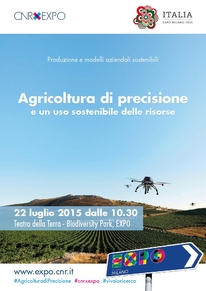Precision agriculture and sustainable use of resources

Coordinator: Alessandro Matese
Institute of Biometeorology (IBIMET)
Interview to Alessandro Matese
What is precision agriculture ?
A set of methodologies, analysis and processes for a site-specific crop management. Basically Precision Agriculture targets the spatial variability that exists in a cropping system and considers the ensemble of units that differs in terms of soil, microclimate and morphology and therefore needs to be managed in a specific way. A vineyard or a corn-field, especially if very extended, turn out to be the combination of many small plots cultivated with the same crop. This heterogeneity is very common in Italian cropping systems.
What is the objective of precision agriculture?
Precision agriculture aims at the maximization of the agronomic potential in terms of yield and of quality of productions while increasing their environmental sustainability. For instance, precision agriculture enhance the ability to fine-tune nutrient management decisions and develop the site-specific nutrient management plan for each field and even for the single plant. Therefore, it is possible to avoid unnecessary treatments, which can be harmful and polluting, and reduce costs.
How did it do?
As a first step, the heterogeneity in a crop must be identified and then monitored. This can be done with several technologies such as remote sensing technologies (from satellite, aircraft of drones) or proximal monitoring such as microclimatic weather stations or other sensors deployed in the field.
A whole set of technologies for agricultural purposes. What else?
Ground optical systems, handheld cameras for temperature monitoring, infrared sensors…. several sensors can be used to collect data on a given plot at high temporal resolution, providing detailed information to characterize the sub-plot variability down to the scale of the single plant. Some technologies are derived from other sectors, such as the use of drones. The data from the different sensors have then to be organized in geo-databases and processed with geostatistical techniques, to describe plant status and the management approaches to be applied to each micro-area
The technologies also are used in other cultivation stages?
All data collected is geo-localized using the GPS. This means that later, after being transferred and processed, these data can be communicated to tractors. The tractor using the GPS can distribute in different area, different quantity of fertilizer or pesticides. There are many different types of machines. For example, variable rate harvesting machines are now available, enabling the selective harvest by grape quality classes. In France a pruning tractor was developed that enalbes a selective pruning in function of the green biomass of each plant.
What kind of event will be organized for EXPO?
Few years ago I participated to the European Conference on Precision Agriculture and I noticed that there were researchers from all over the world, but only a few Italians. I understood then that in our country there is a lacks information on precision agriculture. What is it? Which are the benefits it can brings to Italian agriculture? Which are the costs for implementing such an approach? Who can use it? This event will be an opportunity of discussion between research institutions and companies, informing about pilot experiences in Italy and good practices. Between these two worlds, there should be closer cooperation in order to better focus the research objectives, because, only farmers know what they need.




